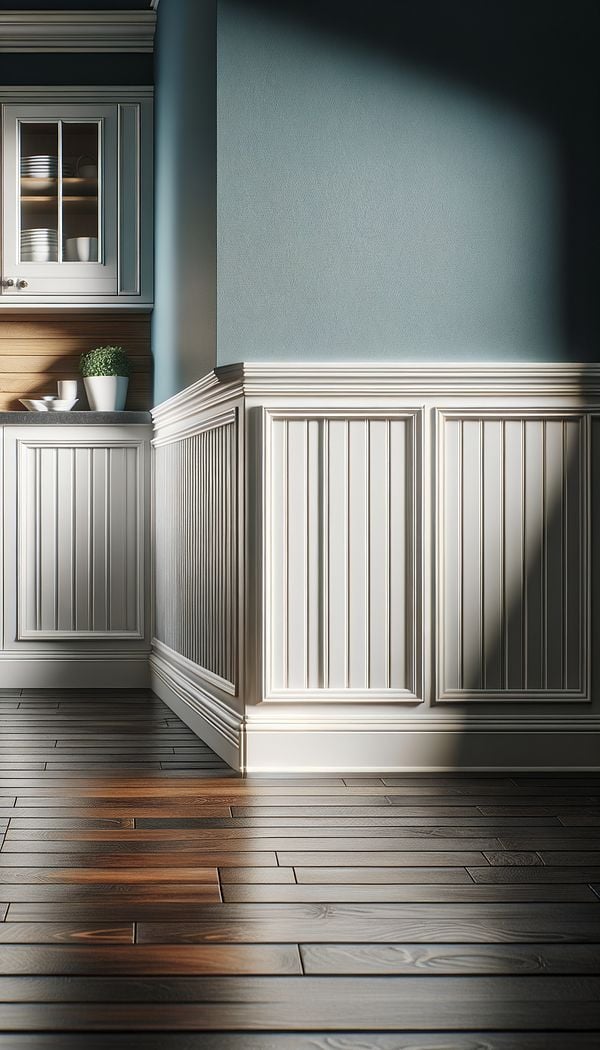What is Beadboard?
Beadboard is a type of paneling characterized by a row of narrow wood planks lined vertically, with each plank featuring a rounded bead-like ridge along its edge.
Description
Beadboard is a versatile material used in interior design for adding both texture and visual interest to walls, ceilings, and various other surfaces. Traditionally made from wood, beadboard consists of slim planks aligned vertically. These planks are distinguished by a distinctive "bead" or rounded ridge that runs along each edge. This bead creates a series of raised lines across the surface of the paneling, giving it a dynamic and textured appearance.
In recent years, beadboard has been available in a variety of materials including MDF (Medium Density Fiberboard), PVC, and other engineered woods, expanding its use to environments where moisture or other considerations might rule out natural wood. These alternatives offer the traditional appearance of beadboard while providing durability, ease of installation, and maintenance.
The use of beadboard in interior design is diverse. It can serve as an elegant wainscoting in dining rooms or bathrooms, give a cozy, cottage-like feel to kitchen backsplashes, or add character to cabinet doors and ceiling treatments. Its adaptability allows it to fit into various design styles, from traditional to more contemporary spaces.
Installation of beadboard can range from individual planks that are nailed and glued into place to large panels that mimic the look of sequential planks. Depending on the material, finishes can vary from painted to stained, offering further customization to match any room's decor.
Usage
Beadboard is commonly used as wainscoting in living rooms, dining areas, and bathrooms. It also appears in kitchen backsplashes, on the ceilings of porches, and as a decorative finish on cabinet doors and islands. In commercial settings, beadboard may enhance the walls of cafes or shops, adding a touch of warmth and texture.
FAQs
-
Can beadboard be used in high moisture areas?
Yes, when made from appropriate materials like PVC or treated wood, beadboard can be suitable for high moisture areas such as bathrooms and kitchens.
-
Is beadboard installation suitable for DIY projects?
Yes, beadboard installation can be a DIY project, especially when using panels. It typically involves measuring, cutting, and affixing the beadboard to the desired surface with nails, glue, or both.
-
Can beadboard be painted or stained?
Absolutely. Beadboard can be painted or stained to match any decor. Wood beadboard benefits greatly from staining, while MDF and PVC beadboards are excellent for painting.
-
How does beadboard impact the style of a room?
Beadboard adds texture and visual interest, creating a sense of warmth and character. It can complement various design styles, from cozy country to sleek modern, depending on the finish and application.
-
What maintenance does beadboard require?
Maintenance is relatively low; it involves regular dusting and wiping down with a damp cloth. Painted beadboard may require occasional retouching.
Practical Application
When considering beadboard for your design project, measure your space carefully and think about the overall aesthetic you wish to achieve. Choose the material based on the room’s conditions, like moisture levels. Pre-painted or pre-finished beadboard can save time during installation. For a unique look, consider using beadboard in unconventional spaces, such as on ceilings or as a kitchen island facade.
-
Design Styles478 articles
-
Materials & Textiles360 articles
-
Decorative Techniques322 articles
-
Construction & Building86 articles
-
Wall Treatments & Finishes157 articles
-
DecoupageDecoupage is a decorative technique where cutouts are glued to a surface and then varnished.
-
Claw & BallClaw & Ball is a decorative motif featuring a claw, paw, or talon grasping a ball, typically used in furniture legs.
-
Rush SeatA rush seat is a type of chair seat made from woven rushes.
-
GildingGilding is the application of a thin layer of gold or gold-like material to a surface.
-
TactilityTactility refers to the sensation and quality of touch in materials, textures, and objects within an interior space.
